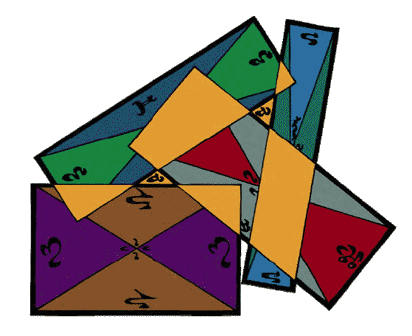The Book of Visitations of Glory
Issue Twelve | Feb 2008
Book of Crystal Bindings
by Barry Blatt
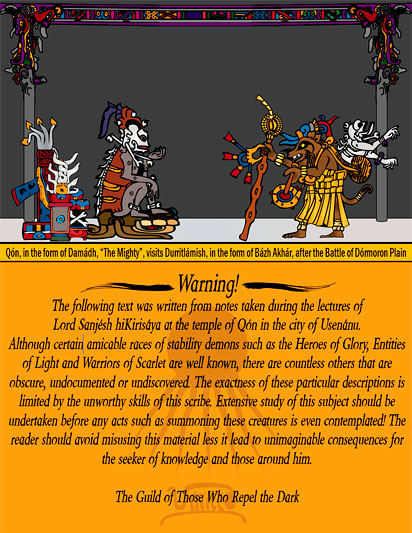
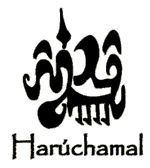
Harúchamal
The Plovers of the Further Shores
This race of demons is of the Substance of Hnálla and the Essence of Belkhánu and dwell on the Plane of Golden Sands, the first of the Paradises Beyond the Isles of Teretané. They appear as birds with rainbow-hued crystalline plumage, steel-grey beaks and four stilt like legs and their eyes shine golden as the eternal sunset of their home plane.
The exact criteria of how souls end up in the Paradises is a matter of continual argument among the philosophers and extra-planar explorers of the Temple of Belkhánu, but is would seem that in some cases gifted people's balétl, or Spirit-Soul can be washed up in the Plane of Golden Sands by the Tides of Dreams. There they are picked over by the Harúchamal, who eat them and then transport the soul to its appropriate fate, be that immolation in the light of Hnálla, being laid as a spirit egg in the body of a newborn sentient back on Tékumel, or as a being on another plane of existence or within a paradise of a specific god.
They are summoned by priests of Belkhánu who bargain with them for their aid in carrying messages to and from long departed souls, and, if they can, to retrieve specific souls and ensure their rebirth on this plane.
The ritual must be carried out at sunset on the shortest day of the year, beginning as the lower edge of the sun’s disc touches the horizon. The summoner, who must be a priest of Belkhánu of at least the 12th circle, stands inside a protective circle drawn in powdered topaz and agate with a choir of fifteen choristers and assistants who chant the sixteenth through eighteenth stanzas of the Hymn of Mórskodel, master of the Harúchamal in endless overlapping cycles.
The light of the dying sun is focused onto a spot on a marble wall in front of the circle through a yellow lens. At the first phrase of the summoning this is made into a nexus point by the use of Visitations of the Other Planes, and the summoner invites the Harúchamal, whose individual secret name he must know, to bargain with him. The second phase involves the sacrifice of at least one M'rúr or Shédra by means of the Viaticum of the Yellow Robe, thus releasing its hlákme back into the Tide of Dreams, an act pleasing to the Harúchamal who will eagerly await its arrival at the farther shores.
The last phase is the striking of the bargain. This must be done quickly and efficiently, as the Harúchamal will leave as the final glimmer of light from the setting sun fades away and the bright nexus point closes behind it. These unearthly birds will demand whole logs of white ssár wood carved into spirals for their nests, agates and quartz crystals, and magical items such as Eyes and Talismans. Under no circumstances should one leave the protective circle to remove the diamond studded golden ticks from the Harúchamal's plumage, even if asked, as the bird will grab your balétl and drop it into the Sea of Souls. Once the bargain is struck the bird flies off to search for the departed soul and returns within seconds. Messages to the dead cannot exceed twenty words and their replies rarely exceed ten.
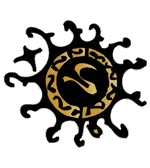
The Harúchamal cannot contact every dead soul. Some are too recently dead and still float among in the seas around the Isles of Teretané. Others have been removed from the endless cycle of souls by having their corresponding bodies made into undead, yet others have been absorbed into the light of Hnálla or the dark of Hrü’u and yet others walk the mundane planes clothed in new bodies. If it cannot find a soul it will at least inform the summoner why before disappearing with its payment.
There is a binding spell that, it is said, can compel a Harúchamal to act as a steed, carrying the summoner to a specific place within the Isles of Teretané or the Paradises Beyond. Those who use this spell must be aware that time often travels at very different rates within these planes and their journey may take centuries to complete.
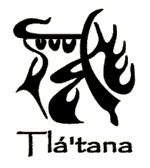
Tlá’tana
The Rod
Tlá’tana is of an unknown substance and the essence of Drá. The deeper nature of this great demon has eluded scholars at least partly because it is impossible, not to say undesirable, to summon It to any plane other than Its own. This is due to both its nature as a supremely disinterested, enigmatic and inscrutable being and its vast size. In the Tale of Long Wanderings there is an account of a party of Stability priests and their entourage, who became lost between the worlds and who, by various accidents and encounters with other demonic races, were brought within sight of this most massive of the servants of the gods.
The unknown author of the tale reported that: It emits an aura of life, yet to the eye is like unto a constructed thing. Within its coral-like body could be glimpsed what our guides called the Ch'tk'tk, apparently in imitation of the sounds they make. Through lengthy negotiations and bartering we obtained from the captain of our vessel the means by which these servant demons could be summoned and compelled to perform their particular function for us. Although we had bought this information in return for an arduous and cruel task in the mines of Ó'lek Shem (note: not otherwise known), yet we judged ourselves blessed when once again we found ourselves in the Emperor's Library in Tumíssa, where this sorry tale had begun so many years before.'
What the task was in the mines is unknown as it is one of three sections of his story—along with the identity of himself and his companions—that the author never revealed. It is likely from the context, however, that the Emperor mentioned was Dharúmesh Mss I, who reigned from 1501 to 1543 AP and that the author was a senior official of the library.
Although Tlá’tana can not be summoned physically into our world, Its breath can, bringing with it Its power of GLACIATION. Those who would do so should be of no less than the 15th circle, and aided by a number of priests of no less than 10th, with a total number not less than three.
Each participant must be clothed as if for the coldest of weather on the highest mountain peak in the uttermost north of the world. No patch of skin must be exposed to the coming of this mighty being's breath. All must also be blindfolded and, despite the difficulty it creates with the ritual, ears must also be protected from the bite of frost.
The summoning consists of a chant, each line of which is sung by one of the participants in order around the space into which the breath of Tlá’tana is to be drawn. This chant is long and requires a complex pattern of notes which will almost certainly require female voices as well as male. The song should be begun at midnight and must completed before daybreak, thus it is not possible to summon Tlá’tana in high summer. (Note: the song itself appears to be lost, but its length maybe judged by this limitation). Any mistake at this point risks removal to the demon's home plane for all, the risk increasing as the chant continues.
It will be seen that each line of the song ends in a partial word, which is completed on the next line and thus by the next singer. As such, each participant must be able to hear and quickly pick up the refrain from the previous. This necessitates that he must be able to hear the priest or priestess who sings immediately before. No other limitation on the size of the area into which the breath is drawn is known, nor does any preparation need to be made of that area.
As the second-last verse is begun, the breath will begin to gather within the polygon delimited by the priests, and to a great height and depth. At this point, all those involved must have their clothing tightly closed in order to protect them from the deadly cold of this demon's exhalations.
The last verse must be sung in unison by all there present and in fact is a charm to prevent the direct touch of the fearsome cold which has the power to overcome any clothing. If the summoners have done all correctly then, as they sing the last line of the last verse, the coldness will pass and the demon will withdraw from the world once more. Should any make a mistake at this point in their singing, then they too, but they alone, will be affected by the demon's breath.
On removing their blindfolds, those present will find the area within their circle greatly changed. All living things will be transformed into brittle statues of themselves, as will many non-living things. A mace swing will suffice to shatter a warrior or a wooden door or an iron bracket. All liquids will be solid lumps down to their foundations, able to support the heaviest of beasts, legions, or siege engines. Frost as thick as a man's forearm will cover almost the whole space. Only volumes so tightly closed that no air may enter or escape will offer protection, and then only if their walls are such that the hottest summer day would not penetrate them.
The summoners are to be cautioned to beware of pools of moisture from the demon's breath. These will be seen bubbling and emitting thick clouds of steam for a few moments after its withdrawal. It is wise not to touch anything that has felt the cold breath with bare skin, but these pools must be avoided completely lest the reckless augment the number of crystalline statues created. Once these pools are gone, the area may be entered carefully.
As the living matter thaws it will be found to be totally dead, with its structure disrupted but usable as food if needed.
The summoning of this demon is very stressful and drains all present of their vigor, the lead priest most of all. As such it is normal for those who perform this summoning to age visibly. Should this cause the lead priest to actually die during the ritual it will spell doom for all involved.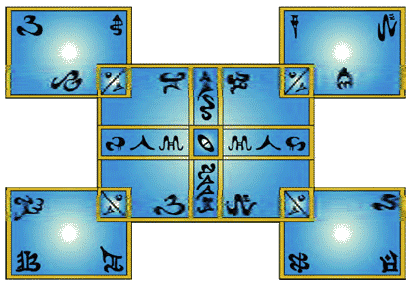
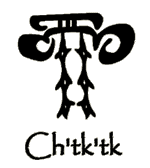
The Ch'tk'tk
These minor demons serve Tlá’tana. They appear to use their powers of RESTORATION, and EXPULSION to keep the great one's physical body clean, although of what is not clear.
They may be summoned simply by any priest of the 8th circle or above using the Dodecahedron of Entreaty, providing that, in addition to the ten ideograms of Stability (note: now obscure) the two symbols below are inscribed on the tuning faces. (Note: sadly, yet again, the transcriber of this copy was unequipped with the special coloured inks probably required for these glyphs. He left a space for them but seems never to have completed the work). A particular Dodecahedron will function but once to summon one of these demons, and thus the summoning is expensive if not arduous (it will be removed by the demon when it leaves).
The beings themselves somewhat resemble shaggy drí-ants, but of great size. They may be commanded to restore any broken item to its original state, although they can not return life to a corpse, IF all the parts are to hand. They will not perform a partial repair.
Alternatively, they may be requested to remove all traces of alien particles—dirt, sand, even concreted stone and parasites—from around or within an object or creature. They appear to be quite unable to comprehend any form of limitation on the applications of their powers and will, for example, to remove food from stomachs and waste from bowels. These processes are carried out with alarming speed using the long fibres which emanate from the demons' many joints.
Finally, the demons' ability to restore objects appears to extend to sending them back to their plane of origin. This is probably how the author of the Tale of Long Wandering and his companions were returned to Tumíssa but again it is important to note that the demons heed no guidance on this matter. If they are requested to restore an object they will both repair and return it to its plane of origin, sometimes to the surprise of a scholar who was unaware of the nature of the archaeological specimen he was attempting to study!
